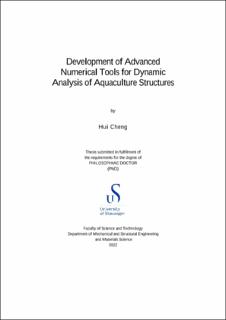| dc.contributor.advisor | Chen, Ong Muk | |
| dc.contributor.advisor | Li, Lin | |
| dc.contributor.advisor | Aarsæther, Karl Gunnar | |
| dc.contributor.author | Cheng, Hui | |
| dc.date.accessioned | 2022-04-26T08:22:59Z | |
| dc.date.available | 2022-04-26T08:22:59Z | |
| dc.date.issued | 2022-04 | |
| dc.identifier.citation | Development of Advanced Numerical Tools for Dynamic Analysis of Aquaculture Structures by Hui Cheng, Stavanger : University of Stavanger, 2022 (PhD thesis UiS, no. 641) | en_US |
| dc.identifier.isbn | 978-82-8439-078-9 | |
| dc.identifier.issn | 1890-1387 | |
| dc.identifier.uri | https://hdl.handle.net/11250/2992729 | |
| dc.description | PhD thesis in Mechanical and Structural Engineering and Materials Science | en_US |
| dc.description.abstract | Numerical methods to accurately predict dynamic responses of marine aquaculture structures are essential in the engineering design process, because these structures can be subjected to large wave and current loads in the ocean environment, which causes complex structural motion and deformation. However, only a few numerical programs for the dynamic analysis of aquaculture structures can be accessed by the public without permission.
In order to meet the high demand for a ready-for-use program, a numerical module for an open-source Finite Element Analysis (FEA) program, Code_Aster, is developed in this PhD study. This numerical module includes various wave models (e.g., Airy waves, Stokes 2nd order waves and irregular waves) and hydrodynamic force models (e.g., Morison model, Screen model and flow velocity reduction due to wake effects). Moreover, a coupling algorithm to handle the wake effects of thin, flexible and highly permeable structures with complex geometries is also implemented to solve the complex fluid-structure interaction (FSI) problem in marine aquaculture engineering. The accuracy of structural response prediction can be improved using the coupling algorithm with the open-source Computational Fluid Dynamics (CFD) solver, OpenFOAM, which can solve the complex flow field around the structures. Detailed verifications and validations are firstly conducted with considerations of different net solidities, inflow angles, incoming current velocities and net dimensions. Subsequently, the newly developed numerical module is applied to study dynamic responses of traditional fish cages, grid moored fish farms and a large semi-submersible aquaculture structure for practical engineering design and optimization purposes.
The structural responses of traditional fish cages with different design parameters (including circumferences of floating collar, depths of net bag, submerged weights) are comprehensively analyzed under pure current conditions. Based on the parametric analysis with a large number of numerical simulations, regression functions for the most concerning aspects are provided for engineering usages in the design process. These regression functions can save considerable time for experiments and numerical simulations in the design of traditional fish cages.
The structural responses of grid moored fish farms are analyzed with respect to combinations of mooring line breakages and current directions. Based on the numerical results, suggestions to improve the design of the mooring system are given. It is also recommended to monitor the positions of buoys during in-situ operations. When one of the mooring line breaks, the maximum tension increment in the mooring system can be estimated based on the displacement of the buoys. This estimation can help the farmer to decide whether the damaged mooring line should be repaired immediately.
The global responses of a semi-submersible offshore aquaculture structure are investigated under irregular waves and current conditions which correspond to a return period of 50 years. The numerical model shows a reasonable agreement with published experimental results and demonstrates that the newly developed numerical module can be applied to the dynamic analysis of offshore aquaculture structures. | en_US |
| dc.language.iso | eng | en_US |
| dc.publisher | University of Stavanger, Norway | en_US |
| dc.relation.ispartofseries | PhD thesis UiS; | |
| dc.relation.ispartofseries | ;641 | |
| dc.relation.haspart | Paper 1: Cheng, H., Li, L., Aarsæther, K.G., Ong, M.C., 2020. Typical hydrodynamic models for aquaculture nets: A comparative study under pure current conditions. Aquacultural Engineering 90, 102070. https://doi.org/10.1016/j.aquaeng.2020.102070 | en_US |
| dc.relation.haspart | Paper 2: Cheng, H., Li, L., Ong, M.C., Aarsæther, K.G., Sim, J., 2021. Effects of mooring line breakage on dynamic responses of grid moored fish farms under pure current conditions. Ocean Engineering 237, 109638. https://doi.org/10.1016/j.oceaneng.2021.109638 | en_US |
| dc.relation.haspart | Paper 3: Cheng, H., Ong, M.C., Li, L., Chen, H., 2022. Development of a coupling algorithm for fluid-structure interaction analysis of submerged aquaculture nets. Ocean Engineering 243, 110208. https://doi.org/10.1016/j.oceaneng.2021.110208 | en_US |
| dc.relation.haspart | Paper 4: Cheng, H., Li, L., Ong, M.C., 2022. Comparative study of five commonly used gravity type fish cages under pure current conditions. Ocean Engineering 250, 110977. https://doi.org/10.1016/j.oceaneng.2022.110977 | en_US |
| dc.relation.haspart | Paper 5: Cheng, H., Ong, M.C., Li, L., 2022. Dynamic simulations of an offshore aquaculture structure under combined wave and current conditions. (OMAE2022, accepted) | en_US |
| dc.rights | Copyright the author | |
| dc.rights | Navngivelse 4.0 Internasjonal | * |
| dc.rights.uri | http://creativecommons.org/licenses/by/4.0/deed.no | * |
| dc.subject | akvakultur | en_US |
| dc.subject | numeriske metoder | en_US |
| dc.subject | marint ingenirøarbeid | en_US |
| dc.subject | marine engineering | en_US |
| dc.subject | aquaculture structures | en_US |
| dc.title | Development of Advanced Numerical Tools for Dynamic Analysis of Aquaculture Structures | en_US |
| dc.type | Doctoral thesis | en_US |
| dc.rights.holder | ©2022 Hui Cheng | en_US |
| dc.subject.nsi | VDP::Teknologi: 500::Marin teknologi: 580 | en_US |

